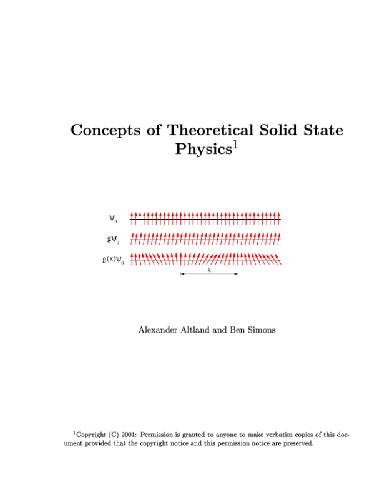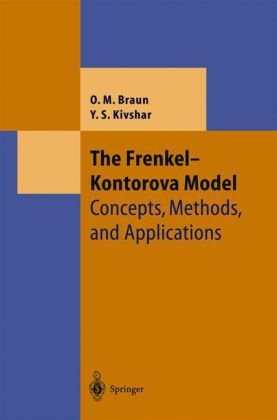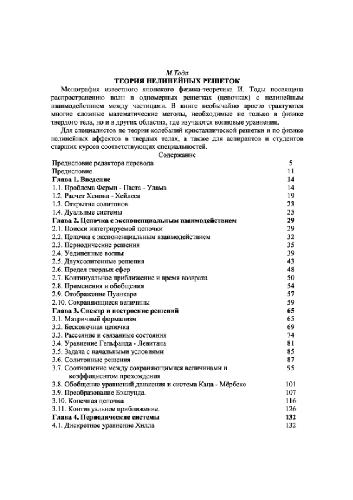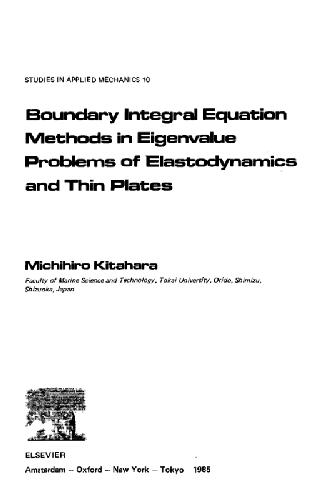Fabian H. L. Essler, Holger Frahm, Frank Göhmann, Andreas Klümper, Vladimir E. Korepin0521802628, 9780521802628, 9780511080722
Table of contents :
Cover……Page 1
Half-title……Page 3
Title……Page 5
Copyright……Page 6
Contents……Page 7
Preface……Page 13
Books……Page 14
Review articles……Page 15
Reprint volumes……Page 16
Instead of a reading guide……Page 17
1.1 On the origin of the Hubbard model……Page 19
1.2 The Hubbard model – a paradigm in condensed matter physics……Page 23
1.2.1 Integrable models……Page 24
1.2.2 Bethe ansatz solution of the Hubbard model……Page 26
1.2.3 The one-dimensional Hubbard model and experiments……Page 28
1.3.1 External fields in three dimensions……Page 29
1.3.2 External fields in one dimension……Page 31
1.4 Conclusions……Page 32
1.A.1 The current operator……Page 33
1.A.2 Linear response……Page 34
1.A.3 Optical conductivity, Drude weight and f-sum rule……Page 36
2.1 The Hamiltonian……Page 38
2.2 Symmetries……Page 43
2.2.1 Permutations……Page 44
2.2.2 Spatial symmetries……Page 45
2.2.3 The momentum operator……Page 46
2.2.4 More discrete symmetries……Page 47
2.2.5 SO(4) symmetry……Page 49
2.3 Conclusions……Page 53
2.A The strong coupling limit……Page 54
2.A.1 Projectors……Page 55
2.A.2 Second order perturbation theory around an energy level……Page 56
2.A.3 The Hubbard model in the strong coupling limit……Page 58
2.A.4 Heisenberg spin chain and Mott transition……Page 60
2.A.5 Neglecting the three-site terms……Page 61
2.A.7 An overview over the strong coupling effective models related to the Hubbard model……Page 62
2.B Continuum limits……Page 63
3 The Bethe ansatz solution……Page 68
3.1 The Hamiltonian in first quantization……Page 69
3.2 Solution of the two-particle problem……Page 72
3.2.2 The centre of mass motion……Page 73
3.2.3 The relative motion……Page 74
3.2.4 Eigenstates on the infinite interval……Page 78
3.2.5 Periodic boundary conditions……Page 79
3.2.6 The Eta-pair……Page 81
3.3.1 The symmetric group……Page 82
3.3.2 Many-particle wave functions and Lieb-Wu equations……Page 83
3.4.2 SO(4) multiplets……Page 85
3.5 The norm of the eigenfunctions……Page 86
3.5.1 An action for the Lieb-Wu equations……Page 87
3.5.2 The norm formula……Page 88
3.6 Conclusions……Page 90
3.A Scalar products and projection operators……Page 91
3.B Derivation of Bethe ansatz wave functions and Lieb-Wu equations……Page 94
3.B.1 The Bethe ansatz wave function……Page 95
3.B.2 Equations for the amplitudes……Page 99
3.B.3 Consistency……Page 102
3.B.4 Periodic boundary conditions……Page 103
3.B.5 Algebraic solution of the spin problem……Page 106
3.B.6 Summary……Page 111
3.C.2 The consistency problem……Page 112
3.D.1 Spin operators in fermionic and in spin chain representation……Page 114
3.D.2 Action of spin operators on Bethe ansatz states……Page 115
3.D.3 su(2) invariance of the spin problem……Page 116
3.E Explicit expressions for the amplitudes in the Bethe ansatz wave functions……Page 119
3.F Lowest weight theorem for the Eta-pairing symmetry……Page 123
3.G.1 Strong coupling limits……Page 130
3.G.2 Continuum limit and Bethe ansatz solution of the model of electrons with delta-function interaction……Page 133
3.G.3 Weak coupling limit……Page 136
4 String hypothesis……Page 138
4.1.1 k-Lambda strings……Page 139
4.1.2 A composition principle……Page 141
4.1.3 Lambda strings……Page 142
4.2.1 k-Lambda strings……Page 143
4.2.2 Lambda strings……Page 144
4.3 Takahashi’s equations……Page 146
4.4 Completeness of the Bethe ansatz……Page 149
4.5 Higher-level Bethe ansatz……Page 151
4.A On deviations from the string hypothesis……Page 152
4.B Details about the enumeration of eigenstates……Page 155
4.B.2 Counting eigenstates……Page 157
5.1 A point of reference: noninteracting electrons……Page 167
5.2 Thermodynamic Bethe Ansatz (TBA) equations……Page 171
5.3 Thermodynamics……Page 179
5.4 Infinite temperature limit……Page 180
5.5.1 Dressed energies……Page 181
5.5.2 Root densities……Page 182
5.5.4 Zero temperature limit in zero magnetic field……Page 184
5.B Properties of the integral equations at T = 0……Page 186
6.1 A point of reference: noninteracting electrons……Page 193
6.2 Defining equations……Page 195
6.3 Ground state phase diagram……Page 196
6.4.1 Fixed B……Page 202
6.4.2 Fixed mu……Page 204
6.5 Spin and charge velocities……Page 205
6.6 Susceptibilities……Page 206
6.6.3 Phase IV: matrix notations……Page 207
6.7 Ground state energy……Page 211
6.A Numerical solution of integral equations……Page 213
6.B Ground state properties in zero magnetic field……Page 215
6.B.1 Half filled band……Page 216
6.B.2 The almost half filled band……Page 217
6.B.3 Low density……Page 219
6.C Small magnetic fields at half filling: application of the Wiener-Hopf method……Page 220
6.C.1 General structure……Page 221
6.C.2 Solution of the equation for y0(Lambda)……Page 222
6.C.4 Dressed energies……Page 224
7 Excited states at zero temperature……Page 227
7.1.1 ‘Single-particle’ excitations……Page 228
7.2.1 Elementary excitations……Page 229
7.2.2 Holon and spinon band widths……Page 234
7.2.3 Spin and charge velocities at half filling……Page 235
7.2.4 Two-particle sector……Page 237
7.2.5 2N particle sector……Page 240
7.3 Root-density formalism……Page 243
7.3.1 The half-filled ground state……Page 244
7.3.2 General excited states……Page 246
7.3.3 Charge singlet excitation……Page 248
7.3.5 Spin singlet excitation……Page 251
7.3.7 Spin-charge scattering state……Page 253
7.4 Scattering matrix……Page 254
7.4.1 Charge sector……Page 256
7.4.2 Spin sector……Page 258
7.4.3 Scattering of spin and charge……Page 259
7.5 ‘Physical’ Bethe ansatz equations……Page 260
7.6 Finite magnetic field and half-filled band……Page 262
7.6.1 Ground state……Page 263
7.6.2 Excitations of the spin degrees of freedom……Page 264
7.6.3 Excitations involving the charge sector……Page 270
7.7 Zero magnetic field and less than half-filled band……Page 271
7.7.1 Charge-neutral excitations……Page 273
7.7.2 Charged excitations……Page 276
7.8 Finite magnetic field and less than half-filled band……Page 279
7.9 Empty band in the infinite volume……Page 280
7.A Relating root-density and dressed-energy formalisms……Page 283
7.B Lower bounds for………Page 285
8.1.1 Finite-size corrections to Takahashi’s equations……Page 286
8.1.2 Finite-size corrections to the energy……Page 289
8.1.3 The dressed charge matrix……Page 291
8.2.1 Zero magnetic field……Page 294
8.2.2 Partially filled spin-polarized band……Page 296
8.2.3 The half-filled band……Page 298
8.2.4 Strong coupling limit……Page 299
8.3 Finite-size spectrum of the open Hubbard chain……Page 301
8.3.1 Bethe Ansatz equations for the open Hubbard chain……Page 302
8.3.2 Surface energy of the open Hubbard chain……Page 304
8.3.3 Ground-state expectation value of n1……Page 305
8.3.4 Finite-size corrections to the energy of the open Hubbard chain……Page 306
8.4.1 Zero magnetic field……Page 308
8.4.2 Half-filling……Page 309
8.4.3 Generic case……Page 310
8.A.1 Weak coupling limit of the dressed charge in zero magnetic field……Page 312
8.A.2 Solution of the strong coupling equations for small B……Page 313
9.1.1 Continuum limit……Page 315
9.1.2 Bosonization and separation of spin and charge degrees of freedom……Page 316
9.1.3 Bosonization results for correlation functions……Page 320
9.2.1 Universality classes……Page 321
9.2.2 Low-lying excitations and correlation functions……Page 323
9.2.3 Extension to models with several critical degrees of freedom……Page 325
9.3 Correlation functions of the one-dimensional Hubbard model……Page 326
9.3.1 Zero magnetic field……Page 328
9.3.2 Half-filled band……Page 332
9.3.3 Magnetic field effects in the strong coupling limit……Page 335
9.4.1 Spectral function……Page 338
9.5 Correlation functions in the open boundary Hubbard chain……Page 342
9.5.1 Friedel oscillations……Page 343
9.5.2 Orthogonality catastrophe……Page 345
9. A Singular behaviour of momentum-space correlators……Page 349
10.1 Construction of the scaling limit……Page 351
10.2.1 Massive charge sector……Page 353
10.2.2 Massless spin sector……Page 354
10.3 Continuum limit……Page 355
10.3.1 Bosonization……Page 359
10.4.1 Spin-charge factorization of correlation functions……Page 362
10.4.2 Spectral representation of two-point functions in the charge sector……Page 363
10.4.3 Form factors……Page 364
10.4.4 Optical conductivity……Page 365
10.4.5 Single particle Green’s function……Page 367
10.4.6 Spectral function……Page 370
10.4.7 Density response function……Page 371
10.4.8 Spin correlation functions……Page 378
10.5 Correlation functions in the continuum limit……Page 379
10.5.1 Optical conductivity……Page 380
10.5.2 Single particle Green’s function……Page 381
10.5.3 Tunneling density of states……Page 383
10.5.5 Density-density response function……Page 384
10.6 Finite temperatures……Page 385
10.A Current algebra……Page 387
10.B.1 Current operator……Page 389
10.C Correlation functions in the Gaussian model……Page 390
11 Universal correlations at low density……Page 394
11.1.1 The gas phase……Page 395
11.1.2 Scaling……Page 397
11.1.3 Universality……Page 398
11.1.4 Asymptotics of correlation functions in the gas phase……Page 399
11.2.1 Determinant representation……Page 401
11.2.2 Differential equations……Page 403
11.2.3 Connection between Fredholm determinant and potentials……Page 404
11.2.4 The Riemann-Hilbert problem……Page 405
11.2.5 Derivation of the asymptotics……Page 406
11.2.6 Asymptotics in the low-temperature limit……Page 407
11.3 Conclusions……Page 410
12.1.1 Integrability……Page 411
12.1.2 The Yang-Baxter algebra……Page 413
12.1.3 The Yang-Baxter equation……Page 414
12.1.4 The standard basis……Page 415
12.1.5 Fundamental models……Page 417
12.1.6 An example – the XXX models……Page 420
12.1.7 Algebraic Bethe ansatz for the gl(2) generalized model……Page 422
12.1.8 Graphical representation of the Yang-Baxter equation……Page 427
12.2 Shastry’s R-matrix……Page 429
12.2.1 The XX models……Page 430
12.2.2 Conjugation matrix and decorated Yang-Baxter equation……Page 433
12.2.3 Constructing the R-matrix……Page 434
12.2.4 Explicit form of the R-matrix (d = 2)……Page 439
12.2.5 Invariances of the Yang-Baxter equation……Page 440
12.3.1 Graded vector spaces……Page 443
12.3.2 Fundamental graded models……Page 447
12.3.3 Global symmetries from local symmetries……Page 450
12.3.4 Fermi operators……Page 451
12.3.5 Examples……Page 454
12.4 The Hubbard model as a fundamental graded model……Page 458
12.4.1 Hamiltonian and L-matrix……Page 459
12.4.2 Symmetries……Page 462
12.5 Solution of the quantum inverse problem……Page 468
12.6 On the algebraic Bethe ansatz for the Hubbard model……Page 470
12.6.1 Classification of the monodromy matrix elements with respect to change of particle number……Page 471
12.6.2 Yang-Baxter algebra in block form……Page 472
12.6.3 Action of the monodromy matrix on the vacuum……Page 473
12.6.4 Hidden six-vertex structure and one-particle states……Page 474
12.6.5 The two-particle states……Page 481
12.6.6 The N-particle transfer matrix eigenvalue……Page 487
12.7 Conclusions……Page 488
12.A.1 The tetrahedral Zamolodchikov algebra……Page 490
12.A.2 The proof……Page 494
12.B A proof of the inversion formula……Page 497
12.D Some identities needed in the construction of the two-particle algebraic Bethe ansatz states……Page 502
12.E An explicit expression for the fermionic R-operator of the Hubbard model……Page 504
13 The path integral approach to thermodynamics……Page 506
13.1 The quantum transfer matrix and integrability……Page 507
Infinite Temperature……Page 513
13.2 The Heisenberg chain……Page 514
13.2.1 Derivation of non-linear integral equations I……Page 516
Alternative derivation……Page 519
13.2.2 Integral expressions for the eigenvalue I……Page 520
13.2.3 Derivation of non-linear integral equations II……Page 522
13.2.4 Integral expressions for the eigenvalue II……Page 526
13.3 Shastry’s model as a classical analogue of the 1d Hubbard model……Page 527
13.4 Diagonalization of the quantum transfer matrix……Page 528
13.5 Associated auxiliary problem of difference type……Page 532
13.6 Derivation of non-linear integral equations……Page 537
13.7 Integral expression for the eigenvalue……Page 543
13.7.1 First integral expression in terms of auxiliary functions……Page 544
13.7.2 Alternative integral expressions……Page 551
13.8 Numerical results……Page 554
13.9 Analytical solutions to the integral equations……Page 565
13.9.1 Strong-coupling limit……Page 566
13.9.2 Free-Fermion limit……Page 567
13.9.3 Low-temperature asymptotics……Page 568
Linearization……Page 569
Dressed function formalism……Page 571
13.10 Conclusions……Page 573
13.A Derivation of TBA equations from fusion hierarchy analysis……Page 575
13.B Derivation of single integral equation……Page 578
14.1 Introduction……Page 581
14.2 The variable-range-hopping Hamiltonian……Page 582
14.3 Construction of the Yangian generators……Page 584
14.4 Special cases……Page 588
14.5 Conclusions……Page 591
14.A.1 Symmetrizers and antisymmetrizers……Page 593
14.A.2 Quantum symmetric functions and a theorem of Kulish and Sklyanin……Page 595
14.A.3 The quantum determinant……Page 600
14.A.4 The Yangians Y(gl(2)) and Y(sl(2))……Page 606
14.A.5 The deformed Serre relation for Y(sl(2)) and Y(gl(2))……Page 608
14.A.6 The Hopf algebra structure of Y(sl(2))……Page 611
14.A.7 Some details of the verification of the Yangian Serre relation for the Hubbard model with variable range hopping……Page 616
15.1 Preliminaries……Page 617
15.2 Passage to the infinite interval……Page 618
15.3 Yangian symmetry and commuting operators……Page 623
15.4.1 Scattering states of electrons……Page 625
15.4.2 Action of the Yangian on scattering states of N electrons……Page 628
15.4.3 Free electron limit……Page 630
15.4.4 Bound states and scattering states of bound states……Page 631
15.6 Conclusions……Page 635
15.A.2 Elements of the monodromy matrix under Yangian transformations……Page 636
15.A.3 Commutators involving the quantum determinant……Page 637
16 Hubbard model in the attractive case……Page 638
16.1.1 Ground state……Page 640
16.1.2 Excitations……Page 642
16.2 The ground state and low-lying excitations below half filling……Page 643
16.3 Interaction with the magnetic field……Page 644
16.4 Phase diagram……Page 645
16.5 Critical behaviour……Page 646
16.6 Thermodynamics……Page 648
16.A Appendix A……Page 651
16.B Appendix B……Page 653
17.1.3 Identities involving the integral kernels……Page 656
17.1.4 A list of useful integral identities……Page 657
17.2 The Wiener-Hopf method……Page 658
References……Page 661
Index……Page 687







Reviews
There are no reviews yet.